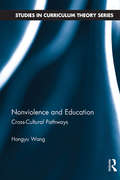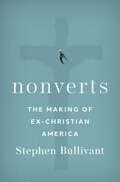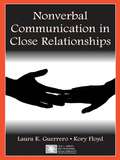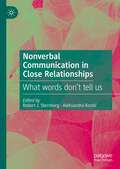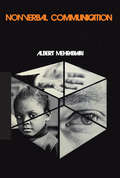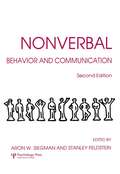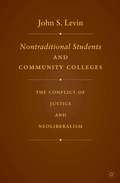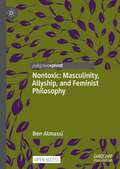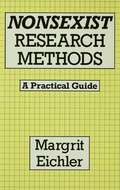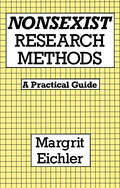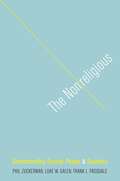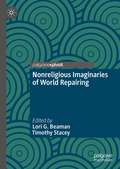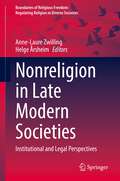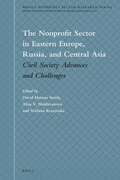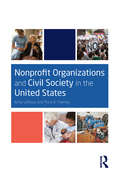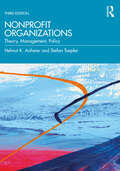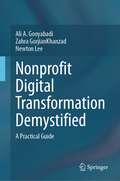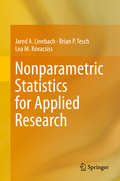- Table View
- List View
Nonviolence and Education: Cross-Cultural Pathways (Studies in Curriculum Theory Series)
by Hongyu WangIn current global politics, which positions China as a competitor to American leadership, in-depth understandings of transnational mutual engagement are much needed for cultivating nonviolent relations. Exploring American and Chinese professors’ experiences at the intersection of the individual, society, and history, and weaving the autobiographical and the global, this book furthers understanding of their cross-cultural personal awareness and educational work at universities in both countries. While focusing on life histories, it also draws on both American and Chinese intellectual traditions such as American nonviolence activism, Taoism, and Buddhism to formulate a vision of nonviolence in curriculum studies. Centering cross-cultural education and pedagogy about, for, and through nonviolence, this volume contributes to internationalizing curriculum studies and introduces curriculum theorizing at the level of higher education. Hongyu Wang brings together stories, dialogues, and juxtapositions of cross-cultural pathways and pedagogies in a powerful case for theorizing and performing nonviolence education as visionary work in the internationalization of curriculum studies.
Nonverts: The Making of Ex-Christian America
by Stephen BullivantAn entertaining and insightful exploration of the American ex-religious The United States is in the midst of a religious revolution. Or, perhaps it is better to say a non-religious revolution. Around a quarter of US adults now say they have no religion. The great majority of these religious "nones" also say that they used to belong to a religion but no longer do. These are the nonverts: think "converts," but from having religion to having none. There are currently has about 59 million of them in the United States. Nonverts explores who they are, and why they joined the rising tide of the ex-religious. One of world's leading experts on contemporary atheism and nonreligiosity, sociologist and theologian Stephen Bullivant draws on dozens of interviews, original analysis of high-quality survey data, and a wealth of cutting-edge studies, to present an entertaining and insightful exploration of America's ex-religious landscape. Bullivant criss-crosses the country, talking to everyone from ex-Mormons in Utah to ex-Catholics in Pennsylvania, from ex-Evangelicals in Georgia to ex-Muslims in California, showing not only what they have in common but also how the traditions they left behind continue to shape them. While American religion is not going to die out any time soon, ex-Christian America is a growing presence in national life. America's religious revolution is not just a religious revolution--it is catalyzing a profound social, cultural, moral, and political impact. Nonverts will serve as an indispensable guide to this shifting landscape, as well as the future of American life.
Nonverts: The Making of Ex-Christian America
by Stephen BullivantAn entertaining and insightful exploration of the American ex-religious The United States is in the midst of a religious revolution. Or, perhaps it is better to say a non-religious revolution. Around a quarter of US adults now say they have no religion. The great majority of these religious "nones" also say that they used to belong to a religion but no longer do. These are the nonverts: think "converts," but from having religion to having none. There are currently has about 59 million of them in the United States. Nonverts explores who they are, and why they joined the rising tide of the ex-religious. One of world's leading experts on contemporary atheism and nonreligiosity, sociologist and theologian Stephen Bullivant draws on dozens of interviews, original analysis of high-quality survey data, and a wealth of cutting-edge studies, to present an entertaining and insightful exploration of America's ex-religious landscape. Bullivant criss-crosses the country, talking to everyone from ex-Mormons in Utah to ex-Catholics in Pennsylvania, from ex-Evangelicals in Georgia to ex-Muslims in California, showing not only what they have in common but also how the traditions they left behind continue to shape them. While American religion is not going to die out any time soon, ex-Christian America is a growing presence in national life. America's religious revolution is not just a religious revolution--it is catalyzing a profound social, cultural, moral, and political impact. Nonverts will serve as an indispensable guide to this shifting landscape, as well as the future of American life.
Nonverbal Communication in Close Relationships
by Laura K. Guerrero Kory FloydNonverbal Communication in Close Relationships provides a synthesis of research on nonverbal communication as it applies to interpersonal interaction, focusing on the close relationships of friends, family, and romantic partners. Authors Laura K. Guerrero and Kory Floyd support the premise that nonverbal communication is a product of biology, social learning, and relational context. They overview six prominent nonverbal theories and show how each is related to bio-evolutionary or sociocultural perspectives. Their work focuses on various functions of nonverbal communication, emphasizing those that are most relevant to the initiation, maintenance, and dissolution of close relationships. Throughout the book, Guerrero and Floyd highlight areas where research is either contradictory or inconclusive, hoping that in the years to come scholars will have a clearer understanding of these issues. The volume concludes with a discussion of practical implications that emerge from the scholarly literature on nonverbal communication in relationships – an essential component for understanding relationships in the real world. Nonverbal Communication in Close Relationships makes an important contribution to the development of our understanding not only of relationship processes but also of the specific workings of nonverbal communication. It will serve as a springboard for asking new questions and advancing new theories about nonverbal communication. It is intended for scholars and advanced students in personal relationship study, social psychology, interpersonal communication, nonverbal communication, family studies, and family communication. It will also be a helpful resource for researchers, clinicians, and couples searching for a better understanding of the complicated roles that nonverbal cues play in relationships.
Nonverbal Communication in Close Relationships
by Laura K. Guerrero Kory FloydNonverbal Communication in Close Relationships provides a synthesis of research on nonverbal communication as it applies to interpersonal interaction, focusing on the close relationships of friends, family, and romantic partners. Authors Laura K. Guerrero and Kory Floyd support the premise that nonverbal communication is a product of biology, social learning, and relational context. They overview six prominent nonverbal theories and show how each is related to bio-evolutionary or sociocultural perspectives. Their work focuses on various functions of nonverbal communication, emphasizing those that are most relevant to the initiation, maintenance, and dissolution of close relationships. Throughout the book, Guerrero and Floyd highlight areas where research is either contradictory or inconclusive, hoping that in the years to come scholars will have a clearer understanding of these issues. The volume concludes with a discussion of practical implications that emerge from the scholarly literature on nonverbal communication in relationships – an essential component for understanding relationships in the real world. Nonverbal Communication in Close Relationships makes an important contribution to the development of our understanding not only of relationship processes but also of the specific workings of nonverbal communication. It will serve as a springboard for asking new questions and advancing new theories about nonverbal communication. It is intended for scholars and advanced students in personal relationship study, social psychology, interpersonal communication, nonverbal communication, family studies, and family communication. It will also be a helpful resource for researchers, clinicians, and couples searching for a better understanding of the complicated roles that nonverbal cues play in relationships.
Nonverbal Communication in Close Relationships: What words don’t tell us
by Robert J. Sternberg Aleksandra KostićThis book is an up-to-date compendium of knowledge on the secret language of close relationships, namely nonverbal routes of communication. In close relationships, as everyone learns sooner or later, the usefulness of words can be somewhat limited, because people (a) mean different things by the same words, (b) mean the same thing by different words, (c) sometimes find it hard to express their feelings in words, and (d) lie. Nonverbal signals therefore often provide the best means of communication. The book points out how decoding (interpreting) nonverbal signals is a major key to success, because often what people say wholly belies how they feel—nonverbal signals reveal their true feelings rather than what they want other people to think their feelings are. This book helps decode those secret signals. The book is written by the leading worldwide experts in the field of nonverbal communication to ensure accuracy, comprehensiveness, and timeliness.
Nonverbal Communication
by Albert MehrabianEven though our society subtly discourages the verbal expression of emotions, most of us, in ostensibly conforming to our roles, nevertheless manage to express likes, dislikes, status differences, personalities, as well as weaknesses in nonverbal ways. Using vocal expressions; gestures, postures, and movements, we amplify, restrict, or deny what our words say to one another, and even say some things with greater facility and efficiency than with words.In this new, multidimensional approach to the subject of nonverbal communication Albert Mehrabian brings together a great deal of original work which includes descriptions of new experimental methods that are especially suited to this field, detailed findings of studies scattered throughout the literature, and most importantly, the integration of these findings within a compact framework.The framework starts with the analysis of the meanings of various nonverbal behaviors and is based on the fact that more than half of the variance in the significance of nonverbal signals can be described in terms of the three orthogonal dimensions of positiveness, potency or status, and responsiveness. These three dimensions not only constitute the semantic space for nonverbal communication, but also help to identify groups of behaviors relating to each, to describe characteristic differences in nonverbal communication, to analyze and generate rules for the understanding of inconsistent messages, and to provide researchers with new and comprehensive measures for description of social behavior.This volume will be particularly valuable for both the professional psychologist and the graduate student in psychology. It will also be of great interest to professionals in the fields of speech and communication, sociology, anthropology, and psychiatry.
Nonverbal Communication
by Albert MehrabianEven though our society subtly discourages the verbal expression of emotions, most of us, in ostensibly conforming to our roles, nevertheless manage to express likes, dislikes, status differences, personalities, as well as weaknesses in nonverbal ways. Using vocal expressions; gestures, postures, and movements, we amplify, restrict, or deny what our words say to one another, and even say some things with greater facility and efficiency than with words.In this new, multidimensional approach to the subject of nonverbal communication Albert Mehrabian brings together a great deal of original work which includes descriptions of new experimental methods that are especially suited to this field, detailed findings of studies scattered throughout the literature, and most importantly, the integration of these findings within a compact framework.The framework starts with the analysis of the meanings of various nonverbal behaviors and is based on the fact that more than half of the variance in the significance of nonverbal signals can be described in terms of the three orthogonal dimensions of positiveness, potency or status, and responsiveness. These three dimensions not only constitute the semantic space for nonverbal communication, but also help to identify groups of behaviors relating to each, to describe characteristic differences in nonverbal communication, to analyze and generate rules for the understanding of inconsistent messages, and to provide researchers with new and comprehensive measures for description of social behavior.This volume will be particularly valuable for both the professional psychologist and the graduate student in psychology. It will also be of great interest to professionals in the fields of speech and communication, sociology, anthropology, and psychiatry.
Nonverbal Behavior and Communication
by Aron W. Siegman and Stanley FeldsteinFirst published in 1987. Routledge is an imprint of Taylor & Francis, an informa company.
Nonverbal Behavior and Communication
by Aaron W. Siegman Stanley FeldsteinFirst published in 1987. Routledge is an imprint of Taylor & Francis, an informa company.
Nontraditional Students and Community Colleges: The Conflict of Justice and Neoliberalism
by J. LevinFocusing on non-traditional students in higher education institutions, this new book from renowned scholar John Levin examines the extent to which community college students receive justice both within their institution and as an outcome of their education.
Nontoxic: Masculinity, Allyship, and Feminist Philosophy
by Ben AlmassiThis open access book argues for allyship masculinity as an open-ended, intersectional model for feminist men. It provides a roadmap for navigating between toxic masculinity on one side, and feminist androgyny on the other. Normative visions for what men should be take many forms. For some it is love and mindfulness; for others, wildness and heroic virtue. For still others the desire to separate a healthy manhood from toxic masculinity is a mistake: better to refuse to be men and salvage our humanity. Though Ben Almassi challenges the visions that Mary Wollstonecraft, bell hooks, and others have offered, he shares their belief that masculinity can be grounded in feminist values and practices. Almassi argues that we can make sense of relational allyship as practices of feminist masculinity, such that men can make distinctive and constructive contributions to gender justice in the unjust meantime.
Nonsexist Research Methods: A Practical Guide
by Margrit EichlerFirst published in 1988. Routledge is an imprint of Taylor & Francis, an informa company.
Nonsexist Research Methods: A Practical Guide
by Margrit EichlerFirst published in 1988. Routledge is an imprint of Taylor & Francis, an informa company.
NONRELIGIOUS UNDERSTANDING C: Understanding Secular People and Societies
by Phil Zuckerman Luke W. Galen Frank L. PasqualeThe number of nonreligious people has increased dramatically over the past several decades, yet scholarship on the nonreligious is severely lacking. In response to this critical gap in knowledge, The Nonreligious provides a comprehensive summation and analysis of existing social scientific research on secular people and societies. The authors present a thorough overview of existing knowledge while also drawing upon ongoing research and suggesting ways to improve our understanding of this growing population. Offering a research- and data-based examination of the nonreligious, this book will be an invaluable source of information and a foundation for further scholarship. Written in clear, accessible language that will appeal to students and the increasingly interested general reader, The Nonreligious provides an unbiased and thorough account of relevant existing scholarship within the social sciences that bears on lived experiences of the nonreligious.
Nonreligious Imaginaries of World Repairing
by Lori G. Beaman Timothy StaceyThe world is confronted with multiple intersecting crises including exploitation, inequality, political polarization and climate change. World-repairing work is vitally needed. But just at a time when humans most obviously require robust moral imaginaries on which to draw, it is no longer clear what kinds of beliefs, meanings, stories and encounters inspire them to act. We know that nonreligious identities are on the rise in numerous countries throughout the world. But with so much focus on the “non” part of nonreligion, what we don’t know is what nonreligious imaginaries actually look, sound and feel like. What do nonreligious people believe in? What stories inspire them? In what moments do they find meaning? This book seeks to answer these questions through a series of short essays exploring the nonreligious imaginaries that emerge in a range of world-repairing practices, including ethical consumption, community organizing, eating habits, and environmental activism. In so doing, the book provides a crucial contribution to two areas of increasing social and political concern: First, the need to understand not only what nonreligious people are rejecting but also their sources of meaning and action. Second, the urgent need for cultural tools for mobilizing people towards more compassionate and sustainable practices.
The Nonreligious: Understanding Secular People and Societies
by Phil Zuckerman Luke W. Galen Frank L. PasqualeThe number of nonreligious people has increased dramatically over the past several decades, yet scholarship on the nonreligious is severely lacking. In response to this critical gap in knowledge, The Nonreligious provides a comprehensive summation and analysis of existing social scientific research on secular people and societies. The authors present a thorough overview of existing knowledge while also drawing upon ongoing research and suggesting ways to improve our understanding of this growing population. Offering a research- and data-based examination of the nonreligious, this book will be an invaluable source of information and a foundation for further scholarship. Written in clear, accessible language that will appeal to students and the increasingly interested general reader, The Nonreligious provides an unbiased and thorough account of relevant existing scholarship within the social sciences that bears on lived experiences of the nonreligious.
Nonreligion in Late Modern Societies: Institutional and Legal Perspectives (Boundaries of Religious Freedom: Regulating Religion in Diverse Societies)
by Anne-Laure Zwilling Helge ÅrsheimThis volume presents results from new and ongoing research efforts into the role of nonreligion in education, politics, law and society from a variety of different countries. Featuring data from a wide range of quantitative and qualitative studies, the book exposes the relational dynamics of religion and nonreligion. Firstly, it highlights the extent to which nonreligion is defined and understood by legal and institutional actors on the basis of religions, and often replicates the organisation of society and majority religions. At the same time, it displays how essential it is to approach nonreligion on its own, by freeing oneself from the frameworks from which religion is thought.The book addresses pressing questions such as: How can nonreligion be defined, and how can the “nones” be grasped and taken into account in studies on religion? How does the sociocultural and religious backdrop of different countries affect the regulation and representation of nonreligion in law and policymaking? Where and how do nonreligious individuals and collectives fit into institutions in contemporary societies? How does nonreligion affect notions of citizenship and national belonging? Despite growing scholarly interest in the increasing number of people without religion, the role of nonreligion in legal and institutional settings is still largely unexplored.This volume helps fill the gap, and will be of interest to students, researchers, policymakers and others seeking deeper understanding of the changing role of nonreligion in modern societies.
The Nonprofit Sector In Eastern Europe, Russia, And Central Asia: Civil Society Advances And Challenges (Brill's Nonprofit Sector Research Ser. (PDF) #1)
by David Horton Smith Alisa Moldavanova Svitlana Krasynska<i>The Nonprofit Sector in Eastern Europe, Russia, and Central Asia (EERCA)</i>, edited by David Horton Smith, Alisa V. Moldavanova, and Svitlana Krasynska, uniquely provides a research overview of the nonprofit sector and nonprofit organizations in eleven former Soviet republics, with each central chapter written by local experts. Such chapters, with our editorial introductions, present up-to-date versions of works previously published in EERCA native languages. With a Foreword by Susan Rose-Ackerman (Yale University), introductory and concluding chapters also explain the editors’ theoretical approach, setting the whole volume in several, relevant, larger intellectual contexts, and summarize briefly the gist of the book. The many post-Soviet countries show much variety in their current situation, ranging from democratic to totalitarian regimes.
Nonprofit Organizations and Civil Society in the United States
by Kelly LeRoux Mary K. FeeneyLeRoux and Feeney’s Nonprofit Organizations and Civil Society in the United States makes a departure from existing nonprofit texts on the market: rather than focus on management, it focuses on nonprofit organizations and their contributions to the social, political, and economic dimensions of society. The book also covers the nexus between nonprofits and civil society. This text offers a theory-oriented undergraduate introduction to the nonprofit field and an examination of the multifaceted roles these organizations play in American society.
Nonprofit Organizations and Civil Society in the United States
by Kelly LeRoux Mary K. FeeneyLeRoux and Feeney’s Nonprofit Organizations and Civil Society in the United States makes a departure from existing nonprofit texts on the market: rather than focus on management, it focuses on nonprofit organizations and their contributions to the social, political, and economic dimensions of society. The book also covers the nexus between nonprofits and civil society. This text offers a theory-oriented undergraduate introduction to the nonprofit field and an examination of the multifaceted roles these organizations play in American society.
Nonprofit Organizations: Theory, Management, Policy
by Helmut K. Anheier Stefan ToeplerIn this new edition of the popular textbook, Nonprofit Organizations: Theory, Management, Policy, Helmut K. Anheier and Stefan Toepler have fully updated, revised, and expanded this comprehensive introduction to a growing field. The text takes on an international and comparative perspective, detailing the background and concepts and examining relevant theories and central issues. Anheier and Toepler cover the full range of nonprofit organizations—service providers, membership organizations, foundations, community groups—in different fields, such as arts and culture, health and social services, and education. Introducing central terms such as philanthropy, charity, social entrepreneurship, social investment, and civil society, they explain how the field relates to public management and administration. This textbook is systematic in its approach to theories, management, and policy. The first edition won the Best Book Award at the American Academy of Management in 2006, and this new edition will continue to match the growing demand for academic teaching. Nonprofit Organizations: Theory, Management, Policy is an ideal resource for students of both undergraduate and postgraduate courses.
Nonprofit Organizations: Theory, Management, Policy
by Helmut K. Anheier Stefan ToeplerIn this new edition of the popular textbook, Nonprofit Organizations: Theory, Management, Policy, Helmut K. Anheier and Stefan Toepler have fully updated, revised, and expanded this comprehensive introduction to a growing field. The text takes on an international and comparative perspective, detailing the background and concepts and examining relevant theories and central issues. Anheier and Toepler cover the full range of nonprofit organizations—service providers, membership organizations, foundations, community groups—in different fields, such as arts and culture, health and social services, and education. Introducing central terms such as philanthropy, charity, social entrepreneurship, social investment, and civil society, they explain how the field relates to public management and administration. This textbook is systematic in its approach to theories, management, and policy. The first edition won the Best Book Award at the American Academy of Management in 2006, and this new edition will continue to match the growing demand for academic teaching. Nonprofit Organizations: Theory, Management, Policy is an ideal resource for students of both undergraduate and postgraduate courses.
Nonprofit Digital Transformation Demystified: A Practical Guide
by Ali A. Gooyabadi Zahra GorjianKhanzad Newton LeeIn this compelling journey into Digital Transformation (DT) tailored for Nonprofit Organizations (NPOs), this book unravels the intricacies of technological integration. Grounded in over one hundred years of extensive research by authors and the editor, real-world examples, and using the San Diego Diplomacy Council (SDDC) as a primary case study, it introduces a tailored Digital Maturity Model (DMM) for NPOs. At the heart of this transformation are three pivotal pillars: Culture, Ethics, and Security.Part I sets the stage, painting a landscape of how NPOs have intertwined with the digital realm. As technology's omnipresence surges, Chapter Two offers a panorama of DT's historical and contemporary intersections with the nonprofit sector. The subsequent chapter emphasizes the stark reality: for many NPOs, digital adaptation is no longer about relevance but survival.Part II delves into the comparative digital strategies of NPOs and their for-profit counterparts in Chapter 4, highlighting the need for tailored approaches. Chapter 5 explores the Nonprofit Digital Maturity Model (NDMM), using the San Diego Diplomacy Council as a focal point. The journey then unfolds further in Chapter 6, which casts a spotlight on the strategic execution of DT in NPOs, weaving in comprehensive analyses to dissect the forces shaping an NPO's digital trajectory.Part III dives deeper, with Chapter 7 laying the foundation of the NDMM. The subsequent chapter meticulously unpacks the NDMM, culminating in Chapter 9, which emphasizes the pillars of DT—Culture, Ethics, and Security—forming the essence of the Nonprofit DT Strategic Framework (NDTSF). This chapter also crafts a tailored roadmap for NPOs, charting a comprehensive DT course.Concluding with a forward-looking stance, Chapter 10 thrusts readers into the enthralling fusion of AI and NPOs, exploring transformative potentials and ethical concerns. Through real-world cases, it positions AI as both a potent tool and a vital dialogue for NPOs. Essentially, this book equips NPOs with tools like the NDMM and insights from successful DT narratives. It seeks to provide a practical guide for nonprofits through their DT journey, ensuring they harness technology ethically and effectively without compromising their core values.
Nonparametric Statistics for Applied Research
by Jared A. Linebach Brian P. Tesch Lea M. KovacsissNon-parametric methods are widely used for studying populations that take on a ranked order (such as movie reviews receiving one to four stars). The use of non-parametric methods may be necessary when data have a ranking but no clear numerical interpretation, such as when assessing preferences. In terms of levels of measurement, non-parametric methods result in "ordinal" data. As non-parametric methods make fewer assumptions, their applicability is much wider than the corresponding parametric methods. In particular, they may be applied in situations where less is known about the application in question. Also, due to the reliance on fewer assumptions, non-parametric methods are more robust. Non-parametric methods have many popular applications, and are widely used in research in the fields of the behavioral sciences and biomedicine. This is a textbook on non-parametric statistics for applied research. The authors propose to use a realistic yet mostly fictional situation and series of dialogues to illustrate in detail the statistical processes required to complete data analysis. This book draws on a readers existing elementary knowledge of statistical analyses to broaden his/her research capabilities. The material within the book is covered in such a way that someone with a very limited knowledge of statistics would be able to read and understand the concepts detailed in the text.The “real world” scenario to be presented involves a multidisciplinary team of behavioral, medical, crime analysis, and policy analysis professionals work together to answer specific empirical questions regarding real-world applied problems. The reader is introduced to the team and the data set, and through the course of the text follows the team as they progress through the decision making process of narrowing the data and the research questions to answer the applied problem. In this way, abstract statistical concepts are translated into concrete and specific language.This text uses one data set from which all examples are taken. This is radically different from other statistics books which provide a varied array of examples and data sets. Using only one data set facilitates reader-directed teaching and learning by providing multiple research questions which are integrated rather than using disparate examples and completely unrelated research questions and data.
